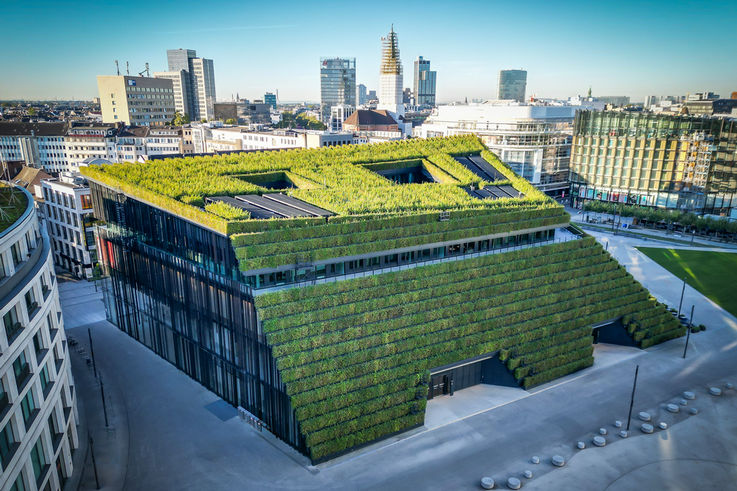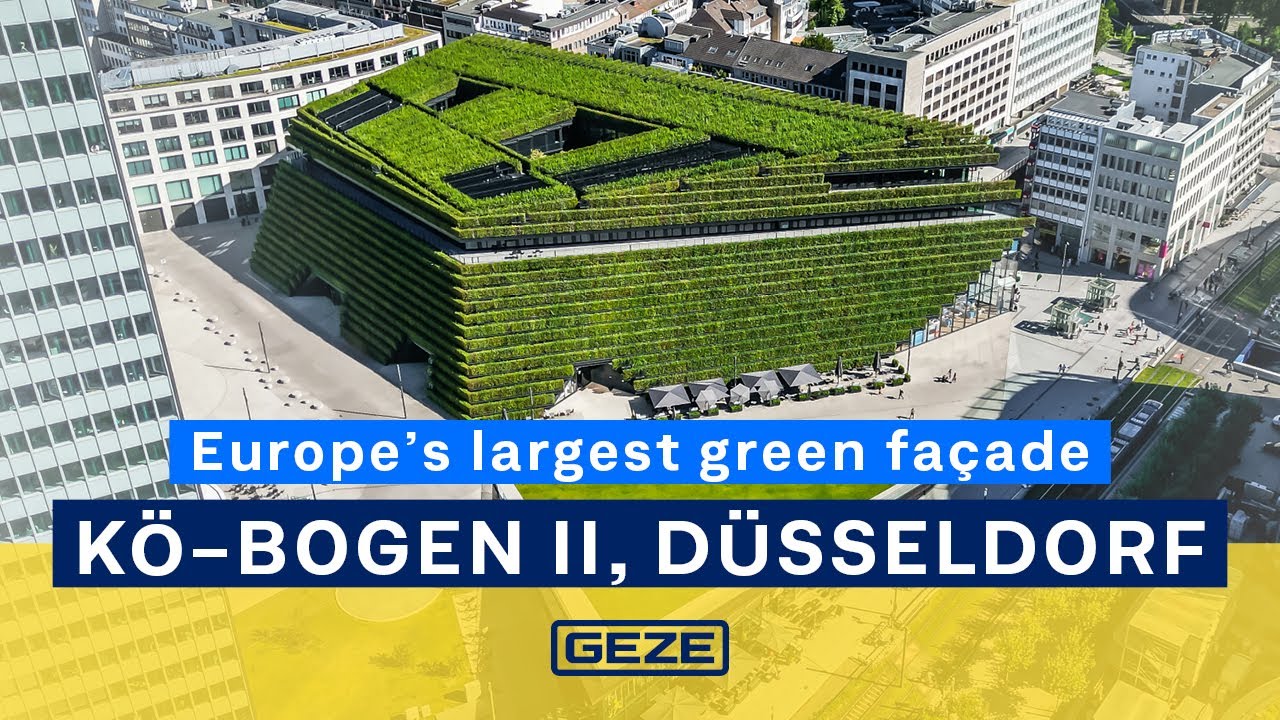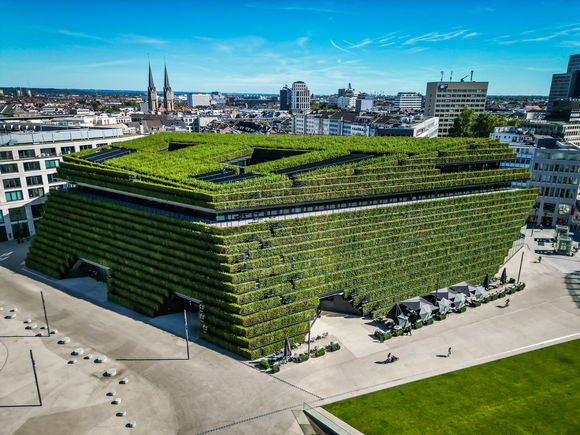Platinum and Diamond: Kö-Bogen II receives the highest DGNB certifications
The commercial and office building Kö-Bogen II in Duesseldorf stands out not only for having Europe's largest green façade: in addition to the DGNB platinum certificate, the Kö-Bogen II is the only building in the world to receive a DGNB diamond distinction - a shining success, including for the environment. The Kö-Bogen II sustainability project shows how it's done.
Forward-thinking: Green Building

DGNB platinum & diamond certificates for the Kö-Bogen II. © Jürgen Biniasch / GEZE GmbH
Sustainable building is becoming more and more important to reduce the environmental impacts of the construction industry. After all, the construction and building sector is responsible for around 30 % of greenhouse gas emissions. Because of this, more and more developers and investors are interested in environmentally-friendly and sustainable buildings and construction projects, known as green buildings.
Internationally recognised: DGNB certifications for sustainable building
The German Sustainable Building Council (DGNB) evaluates the sustainability of buildings. DGNB certification can vary, depending on the level a company is aspiring to attain (gold, silver, bronze, platinum) and the building category (new construction, existing building, district). DGNB certifications are recognised above all in Germany, as well as internationally. An independent review ensures that buildings meet the demanding DGNB criteria.

Documentation and inspections essential for successful DGNB certifications
In order to ensure that the criteria for DGNB certification are fulfilled, it is important for everyone involved - architects, engineers, developers, specialist planners and other trades - to work together closely. Ultimately, detailed verification of all measures taken and their impacts is needed to receive DGNB certification.
- Sustainability: The primary objective of DGNB certification is to evaluate and ensure the ecological, social and economic sustainability of a building.
- Energy efficiency: The building should use as little energy as possible, and ideally should use renewable energy sources.
- Environmental protection: Environmental aspects like water consumption, waste management, and reducing pollutant emissions must be taken into consideration. Using rain water and separating waste are examples of encouraged measures.
- Health and comfort: This includes good air quality, appropriate lighting, and acoustic comfort for building users.
- Area optimisation: It is important to ensure that the available space is used in a smart way.
- Building ecology: The origins and environmental impacts of construction materials are analysed. Sustainable materials and ecological building practices are encouraged.
- Innovation: Integrating innovative technologies and concepts that contribute to sustainability are recognised and rated positively.
- Life cycle assessment: The life cycle costs and impacts of the building are important. This includes not only construction costs, but also operating and maintenance costs throughout the entire life cycle of the building.
- Mobility and access: Good access to local public transit and bicycle parking spaces can boost a building's rating.
- Social responsibility: How the building impacts the local community is taken into consideration, for instance how the building supports the local economy and social interaction.
In addition to its importance as part of Duesseldorf 's urban design, the K II's architecture will set the standard for new, future construction projects, especially in light of issues like resource scarcity and environmental protection."
Stephan Deußer, B&L Group Project ManagerSustainable solutions for successful DGNB certification
Integrating innovative technologies and concepts that contribute to sustainability is rated positively in the DGNB certification. It's no wonder that door technology from GEZE is used in the Kö-Bogen II sustainability project. Many of our products fulfil the sustainability requirements of leading global green building assessment systems, like the ones defined by the DGNB and LEED. We make this conformity transparent by voluntarily providing environmental product declarations (EPDs) for our products. Our products can also be found in the DGNB Navigator and greenbuildingproducts.eu online databases, along with their respective certificates. The certificates certify the number of points with which a GEZE product can contribute to the successful DGNB or LEED certification of a building.
Green, inclined façade - a challenge for door technology

Custom adapted door technology: the GEZE Slimdrive SL NT-FR. © Jürgen Biniasch / GEZE GmbH

The entrances to shops and offices are made visually appealing with the narrow sliding door system. © Jürgen Biniasch / GEZE GmbH
The complex and unique installation situation for sliding and swing door drives in the partially inclined façade, which is covered in hornbeams, was particularly challenging. Due to the very low drive height of just 7 cm, our Slimdrive sliding door systems are perfect in this application: thanks to their low installation height, they integrate cleanly into the green façade.
- The Slimdrive SLV was designed for use on angled façades or corners, for instance on a pavilion, underground garage, or restaurant entrance. The Slimdrive SLV used in project planning for the building was manufactured with the right angle for the drive rail for this project.
- The Slimdrive SL NT-FR with escape route function is used in escape and rescue routes.
- It also offers other advantages in terms of sustainability: the Slimdrive door system efficiently extends its service life with a very smooth running, low-wear DC drive and self-cleaning roller carriages. Automatic error detection and logging also reduce maintenance work, saving resources.
Special solutions for closing edge protection for the green and inclined façade

The proven sliding door system from GEZE ensures standard-compliant protection and night closure despite the sloping façade construction. © Jürgen Biniasch / GEZE GmbH
In addition, we ensured the specified protection of secondary closing edges on the angled façade with unique special solutions. The distance between the protective leaf and façade was so great that there was a danger children, for instance, could get between the protective leaf and façade. Our solution was to include specially planned and manufactured glass and sheet metal panels for closing edge protection. This required intensive collaboration between GEZE project consultants and planning and building protection, as well as other trades.
In such an ambitious project as the Kö-Bogen II, it is essential that all trades work together well from the planning stage. GEZE made a valuable contribution to developing the right building-specific solutions, interdisciplinary planning, and implementation.
Wolfgang Faßbender, Architectural and project consultant at GEZEPlanning advice and maintenance throughout the entire project life cycle
Detailed verifications of implemented measures and their effects are needed for successful DGNB certification. Because of this, reliable and competent planning support and execution from a single source are a major advantage. Our experts offer individual advising and comprehensive services, from planning to assembly, to maintenance and removal if necessary.
Essential for certification of sustainable building projects
Many building projects work to attain certification, since sustainability certificates are often required to receive funding, such as a KfW grant. Michael Halstenberg, Attorney and Ministry Department Head a.D., and Günther Weizenhöfer, Architect and Team Lead of Pre Sales Development, discuss current developments and possible difficulties in case of liability due to a defect.
Key Facts Kö-Bogen II
- Commercial and office buildings in Duesseldorf
- named after Königsallee (Kö)
- Effective area of commercial building: 41,370 m² gross floor area
- 24,000 m² retail and restaurant space, 6,000 m² office space
- approx. 30,000 hornbeams used in the green façade
- DGNB platinum and diamond awards
- ICONIC Awards 2021 - Best of Best
- Green GOOD DESIGN Award 2021
- Design Educates Awards 2021 - Gold Prize
- Draft: ingenhoven architects
- Façade and roof: FRENER & REIFER GmbH
We support you in your planning
Individual solutions from GEZE
Haven't found the right solution for your needs among our standard solutions? Let our experts help you to create a solution from our product range.
Call us on:
GEZE hotline +49-7152-203-0
Architect´s hotline
Our project consultants are available via the GEZE architect hotline (Mo-Thu: 9:00 a.m. - 4:00 p.m. / Fri: 9:00 a.m. - 3:00 p.m.) to provide you with detailed information and advice on our products and their use.
Telephone number: +49-7152-203-112








